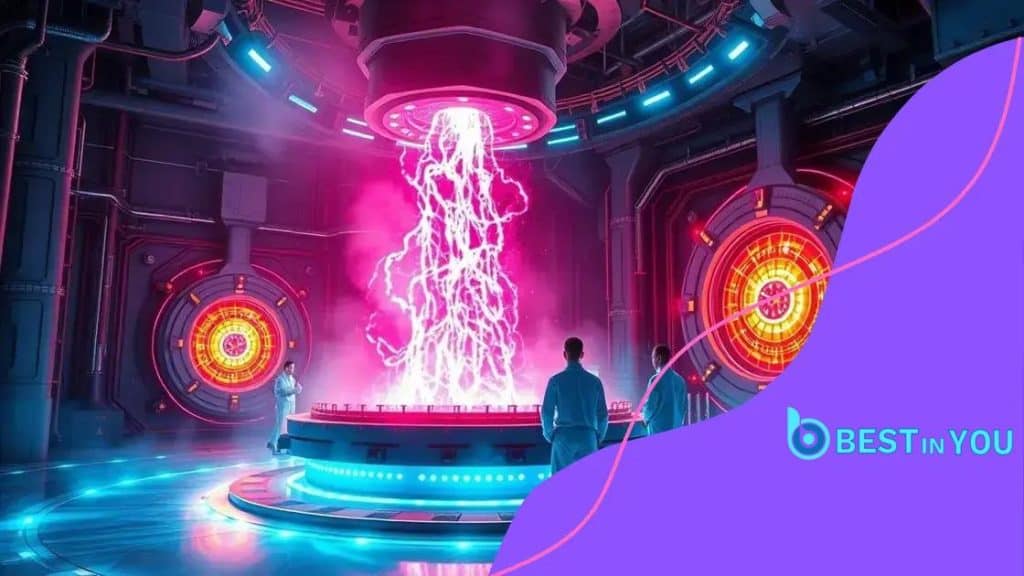Breakthroughs in nuclear fusion energy technology

Advertisements
Breakthroughs in nuclear fusion energy technology offer the potential for a clean, sustainable energy source through advanced reactor designs and global collaboration, despite facing significant technical and financial challenges.
Breakthroughs in nuclear fusion energy technology are paving the way for a new era of energy production. Have you ever imagined a world where energy is clean, safe, and virtually limitless? Let’s dive into the innovations driving this possibility.
Anúncios
Understanding nuclear fusion technology
Understanding nuclear fusion technology is essential as it represents a promising frontier in energy production. At its core, nuclear fusion is the process where two light atomic nuclei combine to form a heavier nucleus, releasing energy in the process. This is the same reaction that powers the sun and other stars.
Fusion occurs under extreme conditions of temperature and pressure. To harness this energy, scientists aim to recreate these conditions on Earth. The most researched method involves using deuterium and tritium, two isotopes of hydrogen.
How does nuclear fusion work?
Nuclear fusion works through a series of steps. Initially, the atomic nuclei need to get close enough to overcome their electrostatic repulsion. This requires high temperatures, often exceeding millions of degrees Celsius.
Anúncios
- Heating: Using techniques like magnetic confinement or inertial confinement to achieve necessary temperatures.
- Confinement: Keeping the plasma stable long enough for fusion to occur.
- Energy release: The fusion reaction produces significant energy in the form of heat.
Once the energy is produced, it can be converted into electricity, much like in traditional power plants. The potential for a virtually limitless, clean energy source makes nuclear fusion technology incredibly exciting. Unlike fossil fuels, fusion does not produce greenhouse gases, and its fuel sources are abundantly available in nature.
Benefits of nuclear fusion
The benefits of nuclear fusion are numerous. First and foremost, it promises high energy yield from minimal fuel. Additionally, the risks associated with fusion are significantly lower than those of fission, which is used in current nuclear power plants. There is no risk of a meltdown, and the byproducts are far less hazardous.
- Safety: Fusion reactions are inherently safer due to the nature of the fuel.
- Environmental Impact: Minimal radioactive waste compared to fission.
- Sustainability: Fusion fuel sources can last for thousands of years.
Scientists and engineers are vigorously working on achieving sustainable nuclear fusion. Current projects, like ITER, aim to demonstrate the feasibility of fusion as a practical energy source. While challenges remain, the path toward successful fusion is exciting and offers hope for a cleaner energy future.
Recent advancements in fusion reactors
Recent advancements in fusion reactors are promising significant progress in harnessing fusion energy. Researchers are making strides in creating stable plasma conditions and sustaining fusion reactions, which are critical for practical energy production.
One notable development is the improvement of magnetic confinement techniques. These advancements allow plasma to be held at extreme temperatures without contacting the reactor walls. This is vital because when plasma comes into contact with material surfaces, it can cool down and disrupt the fusion process.
Innovative technologies
Technologies like the tokamak and stellarator are leading the way in fusion reactor design. Both designs aim to effectively confine and control plasma to achieve sustainable fusion reactions.
- Tokamaks: These are donut-shaped reactors that use magnetic fields to trap the heat and plasma.
- Stellarators: These involve twisted magnetic fields that maintain stability and reduce turbulence.
- Compact fusion reactors: Innovations are also pushing towards smaller reactors that could be more cost-effective and efficient.
Another significant advancement is the development of advanced materials that can withstand the harsh conditions inside fusion reactors. These materials are crucial for the longevity and safety of the reactors. Without durable materials, reactors could suffer damage from radiation and extreme temperatures.
International collaborations
Collaboration among countries is also enhancing research efforts. Projects like ITER in France bring together scientists and engineers from multiple countries to share knowledge and resources. These partnerships aim to accelerate the development of fusion technology.
Overall, recent advancements in fusion reactors indicate that we are closer than ever to making fusion energy a reality. Each breakthrough in technology and collaborative effort brings us one step closer to a cleaner and more sustainable energy future.
The potential impact of fusion energy

The potential impact of fusion energy on our world is vast and transformative. As a clean and virtually limitless source of energy, fusion has the ability to revolutionize how we power our homes, industries, and transportation.
One of the most significant advantages of fusion energy is its minimal environmental impact. Unlike fossil fuels, fusion produces no greenhouse gas emissions. This means a substantial reduction in global warming and air pollution. Additionally, the waste produced from fusion is far less hazardous and shorter-lived compared to that from traditional nuclear fission.
Economic benefits
The economic implications of harnessing fusion energy are also promising. With fusion energy, we could see a decrease in energy costs over time. The abundance of fuel sources, such as deuterium from seawater, means that the costs associated with extracting and producing energy could be dramatically lowered.
- Job creation: The development of fusion technology could lead to the creation of numerous high-tech jobs.
- Energy independence: Countries could become less reliant on imported fuels, enhancing energy security.
- Stable energy prices: Fusion energy could stabilize energy markets by providing a consistent energy supply.
Furthermore, the ability to produce large amounts of energy without damaging the environment can lead to a more sustainable future. Communities can thrive when they have access to reliable and clean energy. Moreover, fusion can support critical developments in sectors such as agriculture, manufacturing, and healthcare.
Global collaboration
The pursuit of fusion energy is also fostering global collaboration. Scientists and engineers from around the world are working together on projects like ITER to share knowledge, funding, and technology. This cooperation accelerates progress and enhances innovation in the field of energy production.
Ultimately, the potential impact of fusion energy extends far beyond just providing power. It holds the promise of a cleaner, more efficient, and more sustainable world. As research and development in fusion technology continue to advance, we edge closer to realizing its incredible benefits.
Challenges facing nuclear fusion development
Challenges facing nuclear fusion development are numerous and complex. Despite the excitement surrounding fusion energy, researchers encounter significant technical and financial hurdles in bringing viable fusion technology to fruition.
One major challenge is achieving the necessary conditions for fusion to occur. Fusion requires extremely high temperatures, often in the range of millions of degrees Celsius. Creating and maintaining this plasma state is not only difficult but also requires advanced materials that can endure harsh conditions.
Technical barriers
Another technical barrier involves the confinement of plasmas. Scientists use magnetic and inertial confinement to hold the plasma stable. Each method has its limitations, and finding a balance between confinement and energy efficiency is critical.
- Magnetic confinement: Involves using magnetic fields to contain the plasma, but these fields must be incredibly strong and precise.
- Inertial confinement: Uses lasers or other means to compress fuel pellets, but timing and precision are essential for success.
- Stability issues: Maintaining a steady state of plasma without disruptions is incredibly challenging.
Financial constraints also play a significant role in the slow progress of fusion projects. Developing fusion technology requires substantial investment, and funding can be inconsistent. Collaborations between governments and private enterprises are crucial to secure adequate resources.
Regulatory and safety concerns
Regulatory hurdles can impede progress as well. Creating safe and effective regulatory frameworks is necessary to ensure public safety and environmental protection. Researchers must demonstrate that fusion reactors can operate safely and prevent harmful accidents, similar to concerns surrounding nuclear fission plants.
Despite these challenges, the progress continues as scientists develop innovative solutions. By addressing these issues, the fusion community remains hopeful that nuclear fusion can become a reliable and sustainable energy source for the future.
Future prospects for fusion energy
The future prospects for fusion energy are incredibly promising, with ongoing research indicating that we may be closer to achieving practical fusion power than ever before. Scientists are optimistic about the potential of fusion to provide a clean and sustainable energy source for generations to come.
One of the main goals in fusion research is to develop reactors that can produce more energy than they consume. This process is called achieving “ignition,” where the energy generated from the fusion reaction exceeds the energy input. Current projects, like ITER in France, aim to demonstrate this critical milestone.
Innovations in technology
Advancements in technology are pushing the boundaries of what is possible with fusion energy. Researchers are exploring various reactor designs, such as the tokamak and stellarator, to improve efficiency and stability. Additionally, innovations in superconducting magnets are enhancing the ability to confine plasma at higher temperatures and pressures.
- Small modular reactors: Future designs may focus on smaller and more efficient reactors that are easier to deploy and manage.
- Advanced fuels: Using different fuel sources, such as helium-3 or advanced isotope blends, could increase the efficiency of fusion reactions.
- AI and machine learning: These technologies can optimize plasma control and reactor operation, potentially accelerating the path to commercialization.
As fusion technology matures, it holds great potential to revolutionize the energy landscape. With the ability to produce large amounts of energy with minimal environmental impact, fusion energy could be a game-changer in the fight against climate change.
Global efforts and collaborations
International collaboration continues to enhance the prospects of fusion energy. By sharing knowledge and resources, scientists from various countries work together to tackle the challenges of fusion research. Such collaborations are critical for accelerating advancements and achieving common goals in fusion development.
The future of fusion energy is filled with possibilities, and as we move forward, ongoing research and development will be crucial in bringing this powerful energy source to reality. The potential to change the way we generate and consume energy could lead to a more sustainable and prosperous future for all.
In summary, fusion energy has the potential to greatly impact the future of energy production. As technology advances and global collaboration increases, we are getting closer to making fusion a reality. The benefits of clean, sustainable, and virtually limitless energy can transform our world. Though challenges remain, the continued research and development in this field inspire hope for a cleaner future for everyone.
FAQ – Frequently Asked Questions about Fusion Energy
What is nuclear fusion?
Nuclear fusion is the process where two light atomic nuclei combine to form a heavier nucleus, releasing a significant amount of energy in the process.
How does fusion energy differ from nuclear fission?
Fusion energy combines atomic nuclei to release energy, while fission splits heavy nuclei into smaller parts. Fusion produces less hazardous waste and does not carry the risk of a meltdown.
What are the main challenges in developing fusion energy?
Key challenges include achieving the extreme temperatures needed for fusion, maintaining stable plasma confinement, and securing sufficient funding for research and development.
When can we expect fusion energy to be commercially available?
While progress is ongoing, most experts believe practical fusion energy may become commercially available within the next few decades, given advances in technology and international collaboration.





